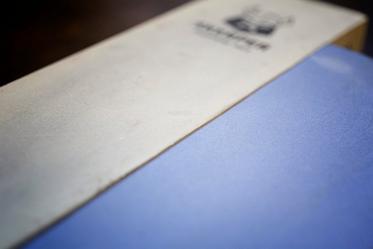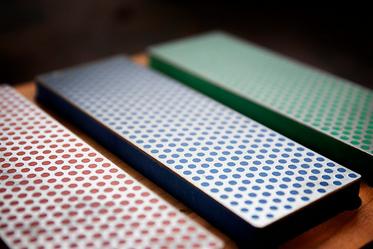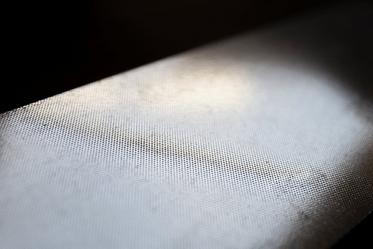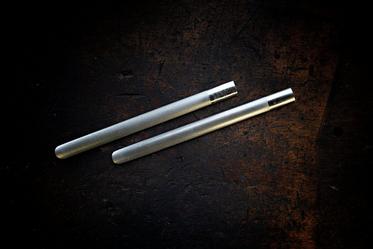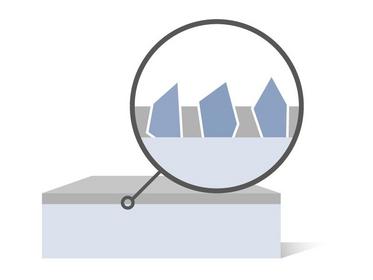Sharpening stone materials: which are the best?
There are many different types and sizes of sharpening stones. In this topic we discuss what materials are used to produce sharpening stones and what the (dis)advantages of these materials are. As such you can decide which material will suit you best. Let's start with the short version. Are you interested? If so continue reading to find out more in the extended version!
In a nutshell:
Sharpening stones can be divided into two categories. Natural sharpening stones and synthetic sharpening stones. Natural sharpening stones are just that, natural stones. These stones were taken from a quarry. Synthetic sharpening stones can be comprised of different materials. The synthetic materials used most often for sharpening stones are ceramics and diamond. Of course each material has its pros and cons.
Natural sharpening stones
Natural sharpening stones are specific stones that were directly taken from a mountain, cut up into straight pieces and wrapped for shipment. Examples of natural sharpening stones are the Ardennes coticule sharpening stones, Skerper Arkansas stones and Belgian Blue stones.
Pros and cons of natural sharpening stones
The main advantage of natural sharpening stones is that in general they last longer than synthetic sharpening stones. In addition, natural sharpening stones slowly remove material. These stones sharpen slowly which means that the end result is a little more refined and controllable. And you sharpen your knife on a completely natural product. That could also be an important advantage to many. The biggest disadvantage is that sharpening takes a little longer than when you use synthetic sharpening stones. And no natural sharpening stone is the same. The grain size and the coarseness of the stone cannot be accurately determined per stone. That is why an estimate is given of, for example, 6000 to 8000 grit. Especially when it comes to the higher grain sizes this isn't something you prefer.
Ceramic sharpening stones
Ceramic sharpening stones are stones where synthetic ceramic particles are combined and turned into one stone. Examples of ceramic sharpening stones are those produced by Spyderco, Skerper, Naniwa and Shapton.
Pros and cons of ceramic sharpening stones
Ceramic sharpening stones are very accurate when it comes to the grain sizes. Because the ceramic particles are synthetically produced you will know for sure that the 8000 grit sharpening stone actually has a grain size of 8000. In addition, there are many affordable ceramic sharpening stones out there. The disadvantage is that there are so many different types of ceramic sharpening stones that all sharpen differently and also leave you with different results because they are made from different ceramic particles. But more about that in the extended version!
Diamond-coated sharpening stones
A diamond-coated sharpening stone is often comprised of a sheet with tiny diamond particles. Because the material doesn't wear out (if you use it properly) you only need a relatively thin sharpening layer. Usually no more than a mm thick! Examples of diamond-coated sharpening stones are stones made by DMT, EZE-LAP and Atoma.
Pros and cons of a diamond-coated sharpening stone
Diamond is the hardest natural material on earth. That is why generally-speaking diamond-coated sharpening stones don't wear out and offer a lot of results. It quickly removes material which means you don't have to sharpen long. You also don't need water or oil during the sharpening process! A little bit of water or WD-40 can, however, make the sharpening process a little smoother. Do keep in mind that at first diamond-coated sharpening stones are quite coarse which means they remove material too quickly. The most important thing to know as you sharpen with a diamond-coated stone is that you hardly have to apply any pressure! If you do you could remove the diamond layer. So don't apply too much pressure and let the diamonds do their job!
Extended version
Technically speaking it is a little more complicated than what we just described. First of all there are two different types of natural sharpening stones, second of all ceramic and diamond-coated sharpening stones are both synthetic sharpening stones. There are, however, so many differences to mention when it comes to natural sharpening stones, ceramic sharpening stones and diamond-coated sharpening stones. Let's start with the natural sharpening stones:
Natural sharpening stones
You can basically use any stone in nature to sharpen your knife. The results, however, differ per stone. From all stones you find in nature there are only a few fine and hard enough to actually function as a sharpening stone. Ever since the dawn of time tools are sharpened on natural stones. As such humanity has centuries worth of experience and knows which natural sharpening stones are best and why. There are two main natural sharpening stones to be mentioned here: Novaculite and Coticule.
Novaculite
The most occurring type of natural sharpening stone is novaculite, also called Arkansas. This is a quartz that has been used as a sharpening stone for hundreds of years. These stones all come from the Ouachita Mountains in Arkansas. These stones are known for their subtle removal of metal and amazing sharpening results. In other words: they sharpen quietly and finely, but are relatively slow. The Skerper Arkansas sharpening stones are novaculite sharpening stones
Coticule
In addition to novaculite, the natural sharpening stones from Belgium are also famous worldwide. These so-called Coticule stones come from one open mine in the city of Vielsalm in the Ardennes. The Coticule stones have a basis of silicon dioxide, also known as silica. Technically speaking a quartz, just like the Arkansas stones. Examples of natural Coticule sharpening stones are Ardennes Coticule sharpening stones and Belgian Blue sharpening stones. Coticule natural stones contain on average between 30% and 40% spessartine. Spessartine is a version of the mineral called garnet. Garnet is one of the hardest natural minerals and therefore perfect for sharpening steel. The garnets are released during the sharpening process, creating a kind of sharpening paste. This paste takes care of the sharpening function of the stone.
Ceramic sharpening stones
You could say that ceramic sharpening stones are made from baked clay but it is a little more complicated than that. The ceramic sharpening stones start their life as (white, brown or grey) aluminium oxide or silicon carbide in powder form. The synthetic powder is created in a laboratory to create the desired grain size (and because you won't find aluminium oxide and silicon carbide in nature). The powder is mixed with a binding agent after which it is pressed into the right shape in a mould. The binding agent is often comprised of natural products such as cellulose, wax, clay and even magnesium, or synthetic products such as: polyacrylates, polyvinyl alcohol or various synthetic resins. The exact process, and the binding agent used, is often not shared and remains the manufacturers secret.
The substance is then heated in the mould to close to the melting point. Often a temperature of 1200 to 1700 degrees Celsius. The exact temperature depends on the powder and binding agent used. At the right temperature the substance sinks together, but does not melt completely. After cooling off the stones are sharpened into straight blocks. The result is a rock-solid ceramic sharpening stone. Examples of these types of sharpening stones are those made by: Skerper, Spyderco, Shapton and Naniwa.
Differences
As you can see the ceramic stones come in different colours and thicknesses. The different colours are often dyes to clearly indicate the difference in grain sizes. The difference in thickness, and also partially the quality of the stone is mostly the result of the binding agent used, the quality of the aluminium oxide and even the temperature at which the stone is baked. As such you are left with the differences between the different ceramic sharpening stones. There are soft sharpening stones that sharpen quickly but also wear out faster. That is why these stones are often a little thicker. There are also hard, thin sharpening stones that sharpen less quickly but do last a whole lot longer. These differences, however, also mean that a sharpening stone with a grain size of 1000 of one brand can leave you with a different result than a 1000 stone from another brand. Despite the fact that these stones have the same grain size on paper. Because of these differences (and we don't mean the different standards such as JIS, ANSI or FEPA, but the actual differences of the stones), we recommend that you purchase stones from one brand if you decide to purchase multiple stones at once. As such you know for sure that you're going up in grain sizes in the right steps!
In addition to the above mentioned ceramic sharpening stones there are also ceramic sharpening stones to which extra sharpening particles were added. Comparable to the garnets in a natural stone these sharpening particles are extra hard and often made from synthetic sapphire. Also known from the watch glass in more expensive watches. Examples of these types of stones are the sharpening stones made by Spyderco and Fällkniven.
Diamond-coated sharpening stones
A diamond-coated sharpening stone is comprised of a base (mostly of aluminium and plastic) enhanced with a thin iron sheet with synthetic diamond sharpening particles. These diamond particles are, of course, not added to the thin iron sheet with some glue. It takes a rather complicated galvanisation process to properly attach the particles to the iron sheet. By means of electricity the iron sheet is covered with a layer of nickel which will keep the diamond sharpening particles together.
Diamond from a lab
The diamonds that are used in the sharpening stones aren't natural diamonds. They are laboratory-grown diamonds that are almost identical to real diamonds at a molecular level. While natural diamonds need millions of years to grow, dozens of synthetic diamonds are produced at the same time in one day. This imitation of a natural primal force can be done in two different ways: HTPT (High Pressure High Temperature) or CVD (Chemical Vapor Deposition). We won't discuss this too much because this is also where it might become too complicated, even for us! With HTPT natural conditions are simulated. Immense pressure and heat (for instance by a BARS-system) is applied to graphite or a small diamond creating the conditions necessary for diamonds to grow. CVD is a process where diamonds can be extracted from hydrocarbon gas. CVD can be used to produce a synthetic diamond by creating the conditions that are necessary for carbon atoms in the hydrocarbon gas to settle on a crystalline substrate. As such millions of synthetic diamonds are grown worldwide that are used for jewellery and as a sharpening agent on sharpening stones!
Cubic boron nitride (CBN)
Sharpening stones with cubic boron nitride are manufactured in pretty much the same way as synthetic diamonds. The particles of cubic boron nitride are galvanized in a metal layer that is placed on a metal base. CBN crystals are also grown under high pressure and at high temperatures to speed up or simulate the natural growing process. The speed of this process, however, is a lot lower than the comparable process used for synthetic diamond.
In terms of hardness diamond and cubic boron nitride are fairly similar. At room temperature, however, diamond wins from CBN. At high temperatures (+700°C) is CBN harder than diamond. You do, however, need to try really hard to create this amount of heat when you sharpen by hand. When you sharpen your kitchen or pocket knife on a sharpening stone this advantage of CBN will not apply. CBN, however, does have a better chemical stability when compared to diamond. Diamond can namely react to the transition metals (nickel, cobalt, chromium) found in some types of steel. It has, however, not been determined if, and to what extent, this also applies to diamond-coated sharpening stones.
The price of sharpening stones with cubic boron nitride is comparable to diamond-coated sharpening stones. Even an expert when it comes to sharpening could have trouble stating the differences between a CBN sharpening stone and a diamond-coated sharpening stone. Whether you choose a sharpening stone with diamond or CBN, you will enjoy it for years to come! An example of a sharpening stone with cubic boron nitride are the Spyderco sharpening rods.
Mono or polycrystalline
The advantage of the CVD method is that it can create both mono and polycrystalline diamonds. A mono crystalline diamond is simply comprised of one crystallite. This crystallite is a few nanometres up to a maximum of 1 mm in size. A polycrystalline diamond is, as you can probably already guess, comprised of multiple combined crystals. The advantage of mono crystalline sharpening stones is that the uniformity of the diamond crystal prevents the diamond from breaking. The crystal will, however, slowly wear out. As such the sharpening stone will sharpen finer and slower. Eventually the diamonds are so worn out that sharpening with the sharpening stone will no longer have any effect. One polycrystalline diamond is comprised of multiple crystals. This diamond slowly dissolves during the sharpening process. As such a new part of the diamond is exposed making sure the sharpening stone maintains the same grain size its entire life and remains as effective. Eventually the diamonds will, however, completely wear out. In both cases the life of the stone depends on the pressure you apply as you sharpen your knives, the material you wish to sharpen and how often you use the sharpening stone. Don't worry, if you use it right a diamond sharpening stone will last for many years!
Exception
The Naniwa Diamond Stones are unique diamond-coated sharpening stones. The Naniwa Diamond sharpening stones are sharpening stones where the diamond particles are not galvanized on a nickel sheet, but bound in a layer of synthetic resin. Comparable to a ceramic sharpening stone.
Conclusion
Looking for quick results? If so a diamond-coated sharpening stone is the answer! It quickly removes a lot of material. The end result, however, is not as sharp as when you use a ceramic sharpening stone. Do you prefer razor-sharp results and you don't mind sharpening a little longer? If so the ceramic sharpening stone will be perfect for you. There are many differences in quality between the different ceramic sharpening stones, so always pick the one that will suit you best! Are you looking for a forgiving and calm sharpening stone? If so go with a natural sharpening stone! You might be sharpening longer but the results are amazing!
Each sharpening stone has a certain grain size. Unsure if you need to start with a coarse or fine sharpening stone? We would love to tell you more about which sharpening stone to start with.
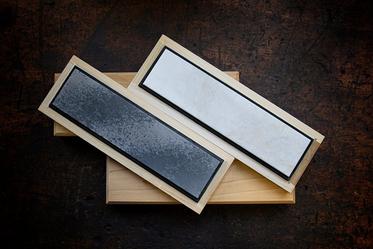


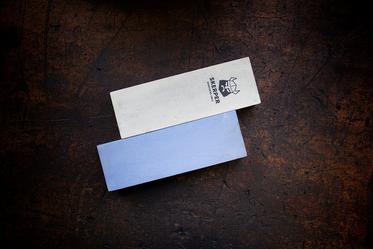


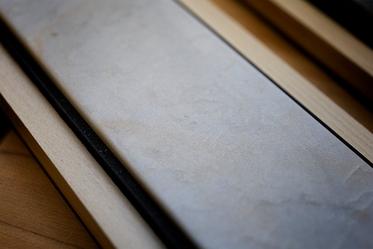
?%24center=center&%24poi=poi&%24product-image%24=&fmt=auto&poi=%7B%24this.metadata.pointOfInterest.x%7D%2C%7B%24this.metadata.pointOfInterest.y%7D%2C%7B%24this.metadata.pointOfInterest.w%7D%2C%7B%24this.metadata.pointOfInterest.h%7D&scaleFit=%7B%28%24this.metadata.pointOfInterest%29%3F%24poi%3A%24center%7D&sm=c&w=373)
?%24center=center&%24poi=poi&%24product-image%24=&fmt=auto&poi=%7B%24this.metadata.pointOfInterest.x%7D%2C%7B%24this.metadata.pointOfInterest.y%7D%2C%7B%24this.metadata.pointOfInterest.w%7D%2C%7B%24this.metadata.pointOfInterest.h%7D&scaleFit=%7B%28%24this.metadata.pointOfInterest%29%3F%24poi%3A%24center%7D&sm=c&w=373)
